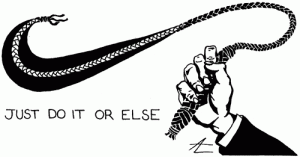It is impossible to go a day without seeing them. They can be found on clothing, uniforms and shoes, on the television and the computer, and on billboards. What are they? They are Nike “swooshes.” This easily recognized brand logo was designed in 1971, and bought by current Nike chairman Phil Knight for 35 dollars. It has been crucial in the growth and popularity of Nike ever since. Although many people have ignored the criticisms targeted at Nike and their corporate practices by continuing to purchase and wear Nike product, many people have protested and written criticisms against the corporate giant.
There are plenty of anti-Nike websites that have provided an outlet for stories and pictures protesting the corporate practices Nike has used in the past and present. Facts and figures are common on these websites as well as creative animations. The original “swoosh” and a variety of these criticizing images can be found below.





Most of these images and animations are pretty self explanatory. They all view Nike in a negative light and are attempting to motivate change. Critics’ voices have been heard, and Nike has adjusted their corporate policies in order to fix the problems with sweat labor. However, images like these are still common and will continue to be used because critics still feel Nike has room to improve.
just copy and paste this! the whole thing
http://skylight.wsu.edu/s/f4f224b0-1fdf-403e-9cc6-04a2abf222eb.srv